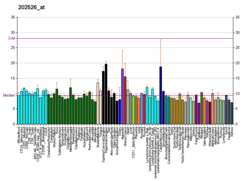SMAD4
| SMAD4 |
 |
|
|
| Identifiers |
| Aliases |
SMAD4, DPC4, JIP, MADH4, MYHRS, SMAD family member 4 |
| External IDs |
OMIM: 600993 MGI: 894293 HomoloGene: 31310 GeneCards: SMAD4 |
| Gene ontology |
| Molecular function |
• protein homodimerization activity
• protein heterodimerization activity
• RNA polymerase II transcription factor binding
• RNA polymerase II regulatory region sequence-specific DNA binding
• chromatin binding
• transcription factor activity, protein binding
• metal ion binding
• transcription factor activity, RNA polymerase II transcription factor binding
• DNA binding
• transcription factor activity, sequence-specific DNA binding
• transforming growth factor beta receptor, common-partner cytoplasmic mediator activity
• identical protein binding
• sequence-specific DNA binding
• core promoter proximal region sequence-specific DNA binding
• transcriptional activator activity, RNA polymerase II transcription regulatory region sequence-specific binding
• transcriptional activator activity, RNA polymerase II core promoter proximal region sequence-specific binding
• I-SMAD binding
• transcription regulatory region DNA binding
• collagen binding
• protein binding
• RNA polymerase II core promoter proximal region sequence-specific DNA binding
• R-SMAD binding
|
| Cellular component |
• nucleus
• cytoplasm
• transcription factor complex
• SMAD protein complex
• nuclear chromatin
• activin responsive factor complex
• intracellular
• RNA polymerase II transcription factor complex
• nucleoplasm
• centrosome
• cytosol
|
| Biological process |
• negative regulation of cell proliferation
• spermatogenesis
• positive regulation of pathway-restricted SMAD protein phosphorylation
• positive regulation of luteinizing hormone secretion
• regulation of cell proliferation
• cardiac septum development
• negative regulation of cell death
• regulation of hair follicle development
• cellular response to BMP stimulus
• epithelial to mesenchymal transition involved in endocardial cushion formation
• brainstem development
• cell proliferation
• regulation of binding
• SMAD protein complex assembly
• metanephric mesenchyme morphogenesis
• positive regulation of epithelial to mesenchymal transition
• positive regulation of transcription from RNA polymerase II promoter involved in cellular response to chemical stimulus
• regulation of transcription from RNA polymerase II promoter
• branching involved in ureteric bud morphogenesis
• regulation of transcription, DNA-templated
• transcription from RNA polymerase II promoter
• embryonic digit morphogenesis
• uterus development
• axon guidance
• somatic stem cell population maintenance
• gastrulation
• positive regulation of histone H3-K4 methylation
• negative regulation of transcription, DNA-templated
• response to transforming growth factor beta
• palate development
• endothelial cell activation
• positive regulation of transforming growth factor beta receptor signaling pathway
• single fertilization
• transforming growth factor beta receptor signaling pathway
• anterior/posterior pattern specification
• in utero embryonic development
• positive regulation of cell proliferation involved in heart valve morphogenesis
• atrioventricular valve formation
• intracellular signal transduction
• developmental growth
• endoderm development
• cellular iron ion homeostasis
• kidney development
• formation of anatomical boundary
• positive regulation of histone H3-K9 acetylation
• regulation of transforming growth factor beta2 production
• interleukin-6-mediated signaling pathway
• negative regulation of transcription from RNA polymerase II promoter
• male gonad development
• ovarian follicle development
• endocardial cell differentiation
• nephrogenic mesenchyme morphogenesis
• gastrulation with mouth forming second
• female gonad development
• SMAD protein signal transduction
• response to hypoxia
• atrioventricular canal development
• mesoderm development
• negative regulation of cell growth
• positive regulation of transcription, DNA-templated
• BMP signaling pathway
• tissue morphogenesis
• positive regulation of transcription from RNA polymerase II promoter
• positive regulation of SMAD protein import into nucleus
• somite rostral/caudal axis specification
• sebaceous gland development
• positive regulation of follicle-stimulating hormone secretion
• positive regulation of BMP signaling pathway
• neural crest cell differentiation
• seminiferous tubule development
• female gonad morphogenesis
• regulation of transforming growth factor beta receptor signaling pathway
• neuron fate commitment
• transcription, DNA-templated
• outflow tract septum morphogenesis
• left ventricular cardiac muscle tissue morphogenesis
• negative regulation of cardiac muscle hypertrophy
• protein deubiquitination
• ventricular septum morphogenesis
• negative regulation of ERK1 and ERK2 cascade
• negative regulation of cardiac myofibril assembly
|
| Sources:Amigo / QuickGO
|
|
|
RNA expression pattern |


|
| More reference expression data |
| Orthologs |
| Species |
Human |
Mouse |
| Entrez |
|
|
| Ensembl |
|
|
| UniProt |
|
|
| RefSeq (mRNA) |
|
|
| RefSeq (protein) |
|
|
| Location (UCSC) |
Chr 18: 51.03 – 51.09 Mb |
Chr 18: 73.64 – 73.7 Mb |
|
PubMed search |
|
|
|
|
|
1DD1, 1G88, 1MR1, 1U7F, 1U7V, 1YGS
4089
17128
ENSG00000141646
ENSMUSG00000024515
Q13485
P97471
NM_005359
NM_008540
NP_005350
NP_032566.2
NP_032566
SMAD 4, also called SMAD family member n°4, Mothers against decapentaplegic homolog 4, or DPC4 (Deleted in Pancreatic Cancer-4) is a protein involved in cell signaling in mammals. It belongs to the proteins of the SMAD family.
SMAD 4 participates in chain reactions inside cells where it interacts with other members of the SMAD family such as SMAD2 or SMAD3. SMAD 4 forms with SMAD 3 a complex which can bind to DNA and modify the expression of several genes related to cellular activities such as proliferation or differentiation. The complex SMAD 3-SMAD 4 is therefore a transcription factor. Intracellular reactions involving SMAD 4 are triggered by the binding, on the surface of the cells, of growth factors from the TGFβ family. The sequence of intracellular reactions involving SMADS is called the SMAD pathway or the transforming growth factor beta (TGF-β) pathway since the sequence starts with the recognition of TGF-β by cells.
...
Wikipedia



